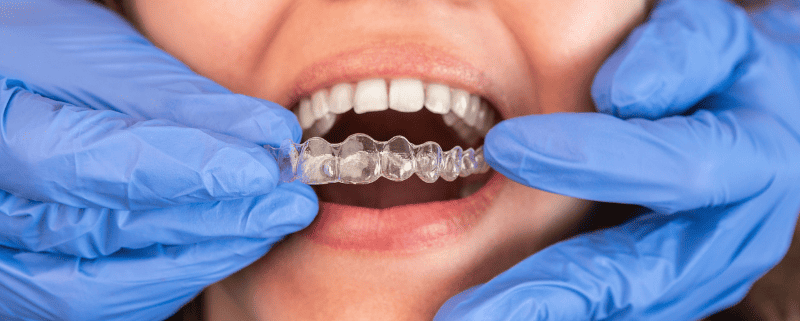Invisalign Vs Braces: Comparing Orthodontic Treatment Options
Last Updated on July 4, 2023 by Gio Greenard
Are you planning to get your crooked, misaligned teeth or over-spacing issues rectified? Then chances are you are tossing between two mostly preferred orthodontic options. It’s Invisalign and braces. Both options are efficient enough to give you accurate and exceptional results. Yet they come with numerous differences.
Choosing between Invisalign or braces can be challenging. You will need to sit with your orthodontist and understand which option will best fit your dental needs. Which means you need to find answers to certain questions. What are braces? What is Invisalign? What are the pros and cons? How do they differ in terms of cost, comfort, convenience, and effectiveness? And so on.
This blog will cover all these concepts in detail. Time to dig in!
Contents
- 1 Everything About Braces
- 2 Everything About Invisalign
- 3 Invisalign Vs Braces Based on Prices
- 4 Invisalign Vs Braces Based on Aesthetics
- 5 Invisalign Vs Braces Based on Comfort
- 6 Invisalign Vs Braces Based on Effectiveness
- 7 Invisalign Vs Braces Based on Convenience
- 8 Invisalign Vs Braces Based on Care and Cleaning
- 9 Invisalign Vs Braces Based on Follow Up
- 10 Invisalign Vs Braces: Which is Better
- 11 Conclusion
Everything About Braces
Braces are a type of orthodontic treatment where brackets are locked to your teeth using wires. These brackets and wires slowly move your teeth in the desired direction. It will keep putting a certain amount of pressure over some time and cause the ligaments to stretch. This will help teeth get the correct alignment. You will need to visit your orthodontist regularly. They will adjust the tightening of braces to ensure correct alignment and measure progress.
| Invisalign | Traditional Braces |
|---|---|
| Clear, removable aligners | Metal or ceramic brackets and wires |
| Less noticeable | More visible |
| More comfortable | Less comfortable |
| Requires discipline for effective treatment | Always in place, ensuring consistent treatment |
| Often more expensive | Generally less expensive |
How Braces Work
Your orthodontist will thoroughly evaluate your teeth with a keen eye. Expect some X-rays to capture every detail. Next up, they’ll meticulously craft brackets and wires, securing them to your pearly whites with precision. The final step entails threading wires through bracket slots and fastening them snugly with rubber bands.
Pros
- Braces easily cure complex issues like bite correction, overcrowding, and misalignment.
- You don’t have to worry about losing them; less patience is needed.
- They cost less than other alternatives.
Cons
- Traditional braces could be more visually appealing. You may face confidence issues at the initial stage.
- Braces always trap food bits, leading to plaque buildup.
- Brackets and wires are always prone to breaking if you eat hard or sticky food. In other words, there are a lot of restrictions when it comes to food intake.
Everything About Invisalign
Invisalign or clear aligners are customized sets of transparent trays you wear over your teeth. These trays will pressure your teeth, moving them in the right direction and giving them a perfect shape. Invisalign is quite a popular choice, given its eye-pleasing aesthetics. These aligners are soft and flexible and fix on your teeth like a cap.
How Invisalign Works
Your orthodontist will take a 3D digital scan of your teeth and use it to create a customized treatment plan. The same scan will also help prepare personalized aligner trays for your teeth. Each tray will use ridges or attachments to put the required amount of pressure on your teeth. However, you will need to change trays at regular intervals to fit the changing teeth movements. Each Invisalign tray will move your teeth in micro increments till you get the perfect smile. You must use Invisalign trays for at least 22 hours daily for better results.
Pros
- Invisalign are aesthetically pleasing and is not easily visible to the naked eye.
- It’s easier to maintain. Since you can take the trays out, you can easily eat, clean, and then put them back.
- They are gentle, comfortable, and convenient.
- Invisalign trays can be easily replaced if broken. It doesn’t lead to any emergency.
Besides, research by Progress in Orthodontics says Invisalign induces less pain compared to other alternatives.
Cons
- You have to clean your aligners daily.
- Since you have to take them out every time you eat, you may lose them.
- Invisalign requires a high level of discipline from the patients’ side. You have to stick to your routine and wear your trays religiously.
- Invisalign may not be effective for treating severe dental complications.
A study by the American Journal of Orthodontics and Dentofacial Orthopedics says Invisalign may not effectively improve dental problems like malocclusion.
Invisalign Vs Braces Based on Prices
Invisalign will always cost you more than braces. Braces usually cost anywhere from $3000-7000. But Invisalign needs frequent checkups, changing of trays, setting and adjustment of trays, etc., it will cost you more: anywhere between $3000-9000.
Fortunately, you will find many insurance plans covering a part of your orthodontic treatments. Also, many dental offices have their own financing options, making your dental plans a little less expensive. So it’s always better to discuss your treatment procedures before diving headlong.
Invisalign Vs Braces Based on Aesthetics
If you are looking for visually appealing options to straighten your teeth, then Invisalign is your solution. They come with transparent trays that are harder to notice at a glance and look like a part of your teeth.
Invisalign Vs Braces Based on Comfort
Traditional braces will cause pain and discomfort in the initial days of your treatment. Your mouth will need time to adjust to the foreign metals and brackets, along with changes in bite and other oral habits. Moreover, an orthodontist will tighten your wire over the period to guide your teeth in the right direction. This makes braces an uncomfortable and somewaht painful process.
Contrarily, you may need some time to adjust to Invisalign, but they are comparatively non-invasive and painless. However, you may see problems like lisping or excessive salivation in the initial phases. Besides, aligner trays will feel soft against the inner cheeks and tongue, unlike the sharp wires of braces.
Invisalign Vs Braces Based on Effectiveness
You don’t have the option to take out your braces once fixed on your teeth. This means the direct force that wires exert will give faster and more accurate results in a short span of time. The level of compliance required from the patient is usually less than other alternatives.
Invisalign, on the contrary, requires a great deal of discipline to ensure accuracy. You have to wear your trays for at least 22 hours daily. Failing will not only prolong the treatment but will also move your teeth in an undesired way.
Apart from this, if you have severely rotated, misaligned, or overlapping teeth, Invisalign may not be able to cure them. Braces would be the right option here.
Invisalign Vs Braces Based on Convenience
Both braces and Invisalign have their share of conveniences and demerits. Braces are convenient because you don’t have to worry about taking them out. But you have to be very careful with your food habits.
With Invisalign, you can eat most foods. You just have to take out your aligner. However, whenever you take out your Invisalign, you must be very careful to avoid losing or breaking them.
Invisalign Vs Braces Based on Care and Cleaning
Braces are hard to clean. They easily trap food debris. It makes your mouth prone to plaque buildup, tooth decay, etc. You have to use soft bristles brush so they can bend easily and pull out food bits from wires.
But Invisalign is easy to clean and care for as you can take out your trays. Though, always be careful not to eat with your Invisalign on. But you have to make sure to clean your trays carefully. Any food particles hiding in the aligner can later lead to tooth decay.
Invisalign Vs Braces Based on Follow Up
Both braces and Invisalign need follow-up visits at regular intervals. Starting with braces, the orthodontist will ask you to pay a regular visit to tighten your wire and adjust your brackets. They will also measure your progress.
Similarly, for Invisalign also, you will have to visit your orthodontist to change your trays. After every phase, you will get a new tray that fits your gradually moving teeth. Once you are done with your braces and Invisalign, you will get retainers to support your newly shaped teeth. Else, chances are it will move back to its previous position.
Invisalign Vs Braces: Which is Better
Both Invisalign and braces come with advantages and disadvantages. Answer these four quick questions to better understand your requirements.
Do You Have Severely Complicated Dental Issues?
Invisalign can treat only moderate teeth and bite alignment problems. If you are facing problems like:
– Larger gaps
– Overlapping
– Rotated teeth
– Overbite
– Crossbite
– Underbite
– Open bite etc.,
Unfortunately, Invisalign might not have all the answers. But don’t worry, braces are here to save the day and provide dependable, precise results!
Do You Want A Non-Invasive Treatment?
Braces are a painful process. The sharp metal wires and brackets often lead to cuts and sores in your mouth. Conversely, Invisalign is softer against the mouth’s roof and tongue and doesn’t lead to injuries.
Are You Disciplined Enough To Wear Your Devices Diligently?
With Invisalign, you need a lot of self-discipline and compliance. Because you can take trays out anytime doesn’t mean you can ignore wearing them. You have to wear your aligners for at least 22 hours. But with braces, you don’t have to worry about taking them out or wearing them, so handling is comparatively easy.
Can You Stick To A Strict Diet?
With braces, you must stick to the food list your orthodontist will give before your treatment begins. You cannot eat hard, sticky, and too chewy foods as they can break the wires of your braces. Similarly, you cannot eat food that’s too hot, spicy, and sugary. But Invisalign gives you all the freedom to eat whatever you want to within reason.
However, always consult and discuss with your orthodontist before you reach a decision. They will examine your dental condition and will tell you which treatment will be more beneficial. They will chart treatment plans to ensure faster outcomes and get you perfectly shaped teeth.
Conclusion
This blog has helped you take a deep dive into Invisalign v braces. And that is how they differ in terms of:
- Cost
- Effectiveness
- Follow up
- Comfort
- Convenience, and so on.
You also learned about the pointers that should be on your checklist when making a decision. So many factors will act as a determiner when you choose your treatment. Do you want a cost-effective treatment plan? Or the treatment that asks for easier cleaning and caring needs? Or do you want a treatment that solves all your dental problems in one go? All these need to be answered before you put your finger on an orthodontic option.
However, always consult and discuss with your orthodontist before you reach a decision. They will examine your dental condition and will tell you which treatment will be more beneficial. They will chart treatment plans to ensure faster outcomes and get you perfectly shaped teeth.

Dr Patti Panucci attended the University of Louisville School of Dentistry for four years, where she graduated with a DMD degree (May 2000) among the Top 10 in her class. Following that, she headed west to Los Angeles to complete her three-year residency at one of the top-ranked orthodontic programs in the country – the University of Southern California.
Along with her certificate in orthodontics, Dr. Panucci earned a master’s degree in craniofacial biology. During those three years, she fell in love with Southern California beach life and decided that this was where her future lay.





Leave a Reply
Want to join the discussion?Feel free to contribute!